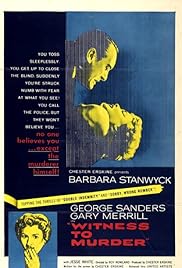WITNESS TO MURDER
(director: Roy Rowland; screenwriters: Nunnally Johnson/ Chester Erskine; cinematographer: John Alton; editor: Robert Swink; cast: Barbara Stanwyck (Cheryl Draper), George Sanders (Albert Richter), Gary Merrill (Lawrence Mathews), Harry Shannon (Capt. Donnelly), Jesse White (Eddie Vincent), Lewis Martin (Psychiatrist); Runtime: 81; United Artists; 1954)
“The camerawork of John Alton is the star of this vehicle.”
Reviewed by Dennis Schwartz
Cheryl Draper (Barbara Stanwyck) can’t fall asleep and is disturbed by the wind, when she goes to close her window she sees in the apartment across the courtyard a man later identified as Albert Richter (George Sanders) choking a woman to death. She phones the police; but, when Lieutenant Larry Mathews (Gary Merrill) and his partner Eddie Vincent (White) arrive to question the historical writer and ex-Nazi accused by Cheryl, there is no dead body.
The detectives are satisfied that no murder took place and tell Cheryl that she must have made a mistake, or had a dream. But Cheryl feels the police have not investigated thoroughly, and sticks to her story.
It is revealed that Richter killed his secret lover because she threatened to interfere with his upcoming marriage to a wealthy society woman. When he sees that Cheryl was snooping around the empty apartment and that she found an earring which she turned over to the police, he decides to turn his attention on her.
Larry is a bachelor cop who is studying to become a lawyer and is attracted to the single woman who works as an interior designer at Sloane’s Department Store. But he tells her there is not one shred of evidence, and after tracing the earring to Richter’s deceased wife he even clears the suspect of that suspicion. He talks Cheryl into doing the sensible thing and forget about it.
But Richter can’t forget about the threat he perceives from the witness. He visits Cheryl’s apartment and fixes her doorlatch so that he can open it, and then returns when she is not home to type up some letters accusing him of murder. He will bring them to the captain, Larry’s superior, and the captain will put Cheryl under mental observation, where she spends a brief time at the mental hospital ward until Larry frees her.
Warning: spoiler in the next paragraph.
At that point of the story, it becomes too melodramatic and incredible for even these fine performers to bring credibility to it. The climax comes when Cheryl must confront Richter, as she sees him buying up all the newspapers at a stand and realizes that there is a story in all the papers of a missing woman who is found dead. When she confronts Richter that she now knows the name of the victim, he goes into a stereotypical Nazi spiel. The film culminates as Richter tries to kill Cheryl as she runs into a construction site. But Larry arrives to fight Richter off.
The camerawork of John Alton is the star of this vehicle. His camerawork sets a dark mood of the Los Angeles scenario, escalating the dramatics with shadowy building shots. The twist in the story is that as upstanding a citizen as Stanwyck is, the authorities still side with the Nazi Sanders because he has a higher status. The noir theme of alienation is richly furnished. But the rub is in the story’s credibility — Stanwyck was just too strong a character to be so completely victimized.

REVIEWED ON 7/31/2000 GRADE: B-